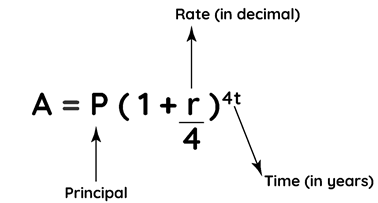About Quarterly Compound Interest Formula
Let us review a few concepts regarding compound interest before studying the quarterly compound interest calculation. In compound interest, each period's interest is computed using the preceding period's amount. This signifies that the previous period's principle becomes the current period's principal. Adding interest to the current principal amount is known as compounding. Compounding can be done on a daily, weekly, monthly, quarterly, half-yearly, or yearly basis. The formula for the final amount in compound interest is:
A = P (1 + r / n)n t
Here,
- P = principal amount
- r = rate of the interest
- t = time in years
- n = number of times amount is compounding.
A quantity that compounds quarterly means it compounds four times every year. i.e., n = 4. This is where the quarterly compound interest formula comes from. As a result, the quarterly compound interest formula is:
P (1 + r/4) 4t = A
???????
The whole amount (Principal + Interest) is denoted by A. In the following part, we'll look at how the quarterly compound interest formula is used.
Our experts prepared a List of all Maths formulas used in different calculations.